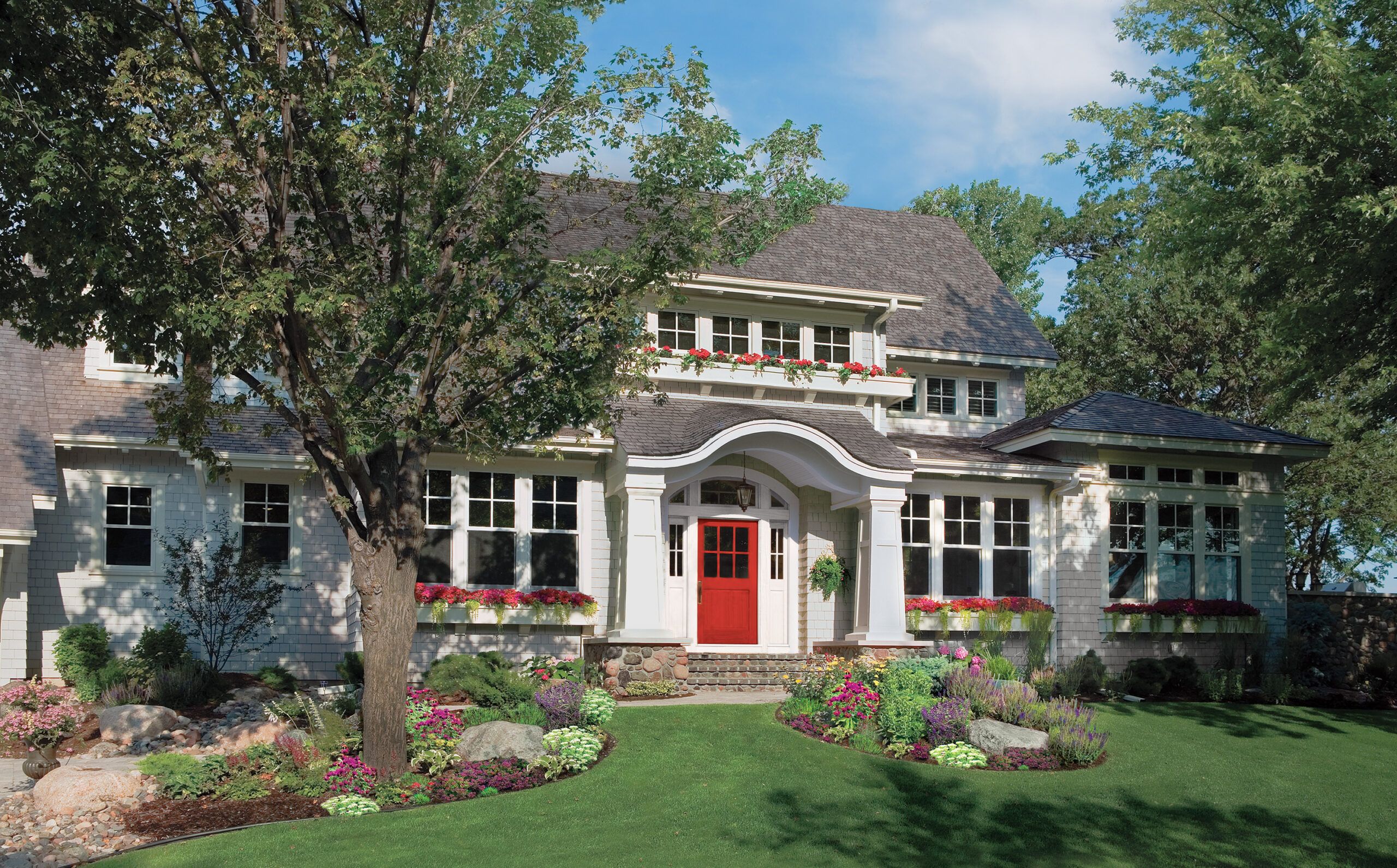According to data from the National Association of Realtors (NAR), some of the simplest, most budget-conscious curb appeal improvements can help you recoup quite a bit of money at resale. This includes improvements that reduce energy use or maintenance. An Energy Star picture window to replace a pair of drafty double-hung windows, or a steel front door with a vibrant factory finish that will never need repainting, are good examples of this.
Ideas To Improve Curb Appeal
For help freshening up your home’s exterior with an eye toward your bottom line, check out these six curbside design ideas and how they work on different houses.
1. Standout Windows
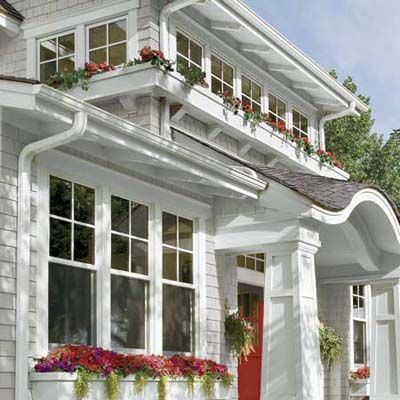
Windows are architectural focal points that can dramatically impact your home’s curb appeal. Here are some ways to make them stand out:
- Add shutters: Install decorative shutters that complement your home’s style and color scheme.
- Add window boxes: Charming flower boxes can infuse color and life into your home’s exterior.
- Experiment with trim: Accentuate windows with decorative trim or molding to create depth and visual interest.
- Paint: Use contrasting colors for window frames and shutters to make them pop against the siding.
2. Inviting Landscape

A well-tended landscape that’s in proper proportion to the house can accentuate the architecture around it. Consider these landscaping tips:
- Add hardscaping: Incorporate elements like stone pathways or decorative borders to add structure and visual interest.
- Choose the right colors: Select flowers and foliage that complement your home’s exterior color scheme.
- Put some light on the subject: Use landscape lighting to highlight key features and create a warm, welcoming ambiance at night.
- Size and layer the plants: Choose plants and trees that match your home’s size and scale. Create depth by placing taller plants at the back and shorter ones in front.
- Think year-round: Adding both evergreen and deciduous plants will help your landscape look good year-round. A few drought-resistant plants are also a good addition, just in case the weather turns dry.
3. Welcoming Entry
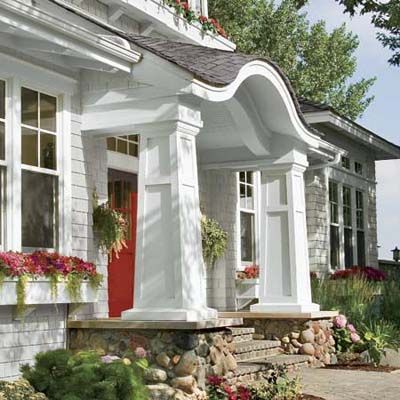
A welcoming porch or portico sets your home’s tone for visitors. Here are a few ways to give it a makeover:
- Choose a bold front door and hardware: Choose a door style and color that complements your home’s architecture and makes a bold statement. You should also update the hardware around your front stoop to match, including doorknobs, knockers, and house numbers.
- Decorate with nature in mind: Potted plants and seasonal greenery like wreaths can make the space feel cozier.
- Install versatile light fixtures: Install attractive and functional light fixtures to illuminate the entry and create a warm glow.
- Make a sitting area: If space allows, add a small bench or set of chairs so guests aren’t always on their feet.
- Think porches: If you don’t have a porch or portico, consider building one to frame the front door and provide shelter.
4. Unifying Paint
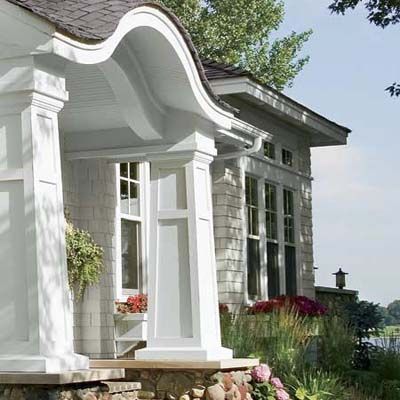
The right paint color can transform your home’s exterior and complement the landscape. Consider the following tips when choosing a shade:
- Consider everything: Your siding is only one part of a whole exterior. Think about paint colors that would complement your roof and stonework as well.
- Quality matters: Invest in a higher-quality exterior paint if you can. It’s a little more expensive up front, but it also goes on more cleanly and lasts longer.
- Test it out: Before you commit to a paint color, test some samples on your home’s exterior in different lighting conditions.
- Think of the neighbors: Even if you don’t have a finicky neighborhood HOA breathing down your neck about paint colors, you can still base your color choice on what your neighbors used to paint their own exteriors.
5. Shipshape Siding
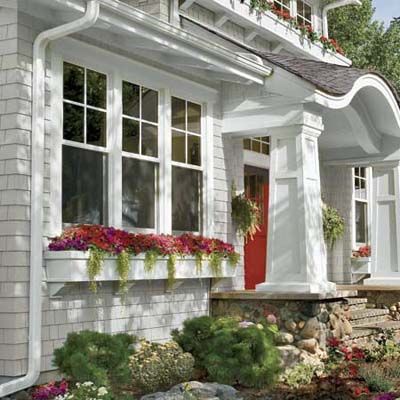
Shingles, clapboards, and masonry are the backdrop for all other exterior details. Regularly clean your siding and inspect it for damage a few times per year. If you’re looking for new siding to completely remodel your exterior or patch damage, look for energy-efficient models that hold heat in to save you money on power bills.
6. Handsome Roof
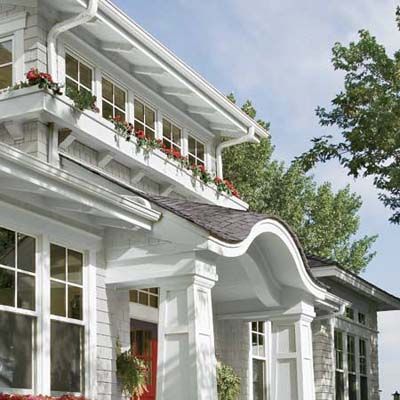
Your roof shelters your front facade’s built-in details. Keep the shingles in good shape, and address any damaged or missing ones as soon as you notice them. If you’re replacing your roof, choose a material that complements your home’s style and color. Like siding, some roofing is also energy-efficient and is better at keeping heat inside.
Curb Appeal Case Studies
Now that you know some of the best ways to boost curb appeal, we’ll show you how homeowners applied these tips for their own front facades.
Case Study 1: A Total Makeover
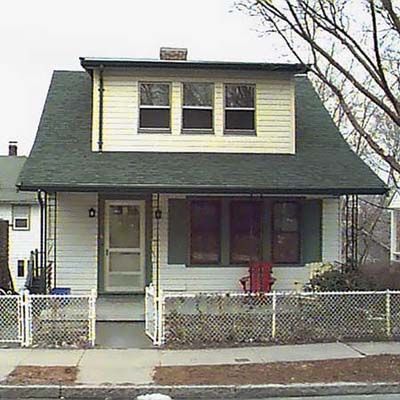
This small Craftsman cottage suffered from drafty original windows that had lost their charm and functionality. Over time, the white siding paired with the white fencing washed out the home’s architectural features. And with limited front yard space, entertaining was difficult. The homeowners determined it was time for a complete overhaul, and it cost less than $2,000 at the time.
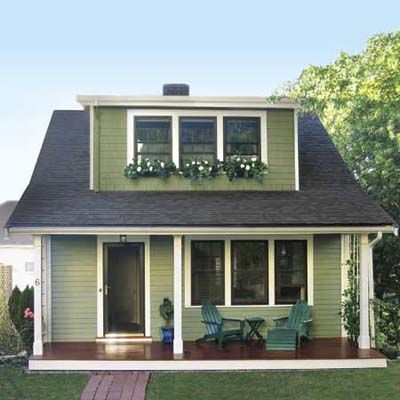
With a little planning, even standard windows can become distinctive. The homeowners installed new simulated divided-light, vinyl-clad wood windows with flat trim. Three flower-filled boxes, one in front of each window, add some pops of color and depth to the facade, and trellises on either side of the porch serve as privacy screens.
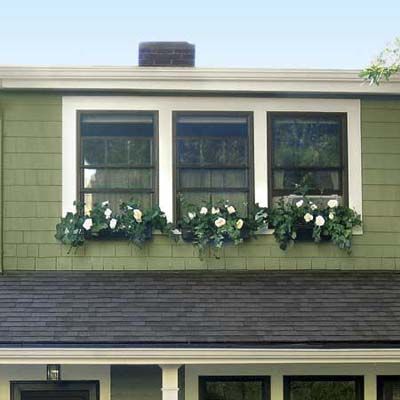
Inspired by other Craftsman homes, the homeowners chose a soft sage green color to cover the siding. They added dimension by painting the window and door frames hunter green, then surrounding them with crisp white trim.
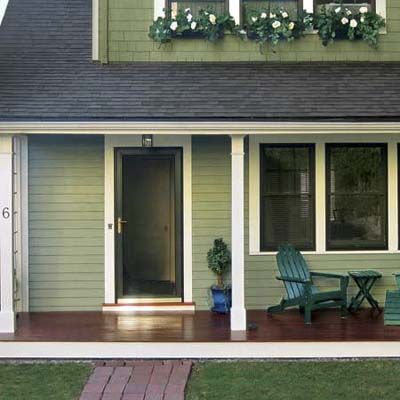
Rustic brick pavers complemented the new earthy color scheme and replaced the gray concrete path. To warm up the porch’s tone, the homeowners added red-stained mahogany decking and tacked simple white fascia boards to the front and sides. Stockier wood posts replaced rusted-out thin metal poles, and an Arts and Crafts style overhead light took the place of two small sconces that flanked the door.
Case Study 2: Better Landscaping
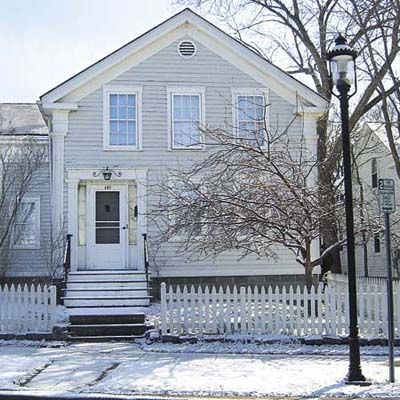
This Greek Revival home’s stark front yard left its facade looking flat and uninviting, and it did nothing to highlight the subtle, unique architecture.

Thanks to some savvy and cost-conscious planting and hardscaping choices, the house and the small lot it sits on look larger.
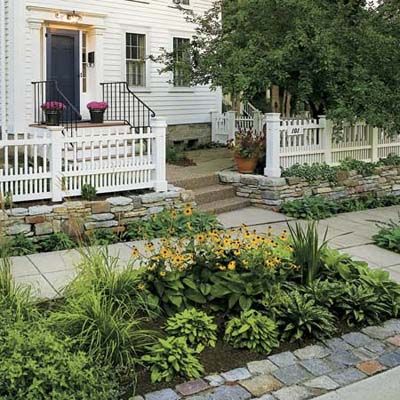
By planting in the strip between the sidewalk and the street, something that’s allowed in many towns, the path to the new six-panel navy blue front door seems longer. The homeowners used native plants requiring less water and fertilizer to save on upkeep costs.
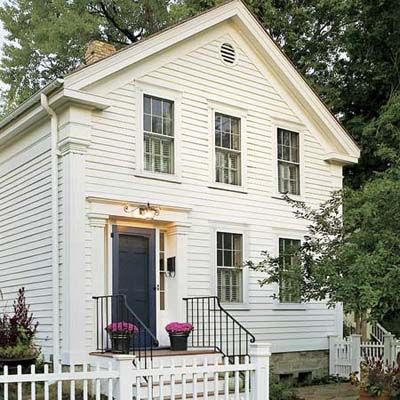
A whitewashed fence with an upper row of thin, wide-spaced spindles opens up the view into the yard. Below the fence, a stacked-stone retaining wall echoes the home’s sturdy foundation and creates a border between the planting strip and the street. Weather-resistant pipe replaced the cedar decking on the stoop and steps.
Case Study 3: Adding a New Porch
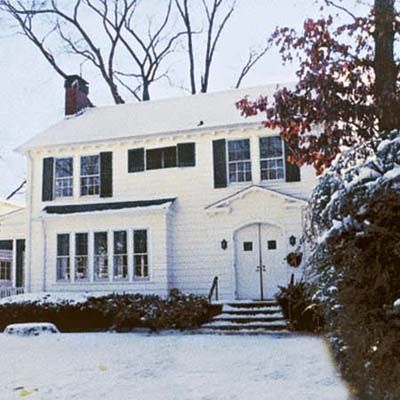
This Colonial Revival home suffered from a cold, flat facade. But it was nothing that some coats of paint and a new wraparound porch couldn’t solve.
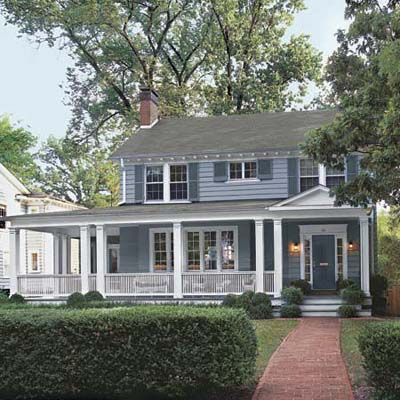
Be it a compact portico or sweeping veranda, a sheltered entry adds balance and interest to the front of any exterior. And compared with the cost of an insulated addition, it extends living and lounging space for a lot less money.
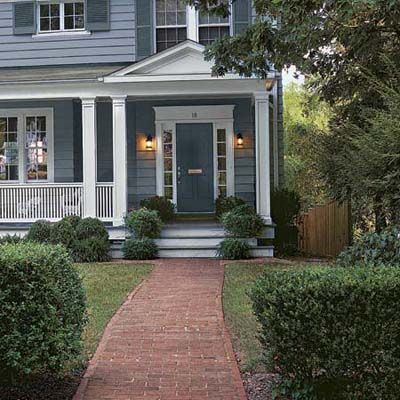
The homeowners added some well-manicured hedges at the lot line and placed similar-looking potted plants leading up to the porch. As for the old double-doors, they were replaced with a single four-panel front door topped with a historical dormerlike pediment.
Case Study 4: Unifying with Paint

This 1970s split-level home had a two-tone effect: red brick on the first story, topped by white clapboards on the second. It was a visual disconnect that made the house look top-heavy and distracted from the graceful double-door entry. The homeowners decided to unify the look with some new color.
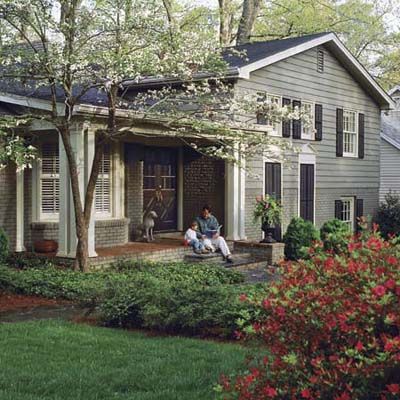
The front of a house should have a pleasing composition without any jarring notes. One earthy hue now merges the two halves of the split level.
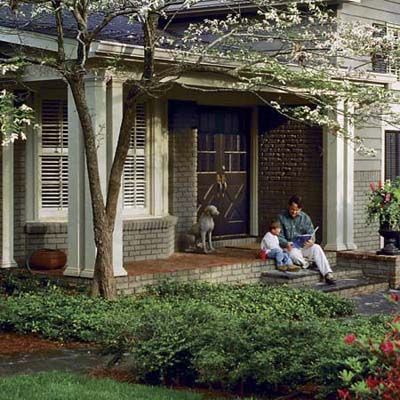
The homeowners chose a Georgianesque mix of gray, black, and white accent colors with low sheen. It’s a more stately palette, and attracts less dirt and plant debris than matte finish paint.
New posts placed just at the sides of the portico replace the view-obstructing originals, so the double doors and bay window can take center stage. Three inexpensive posts grouped together look like one large column, but they cost less and make a more open feel.
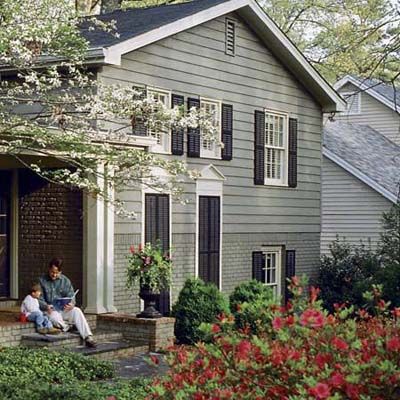
To the right of the front door, two sets of tall inoperable shutters capped with triangular white pediments trick the eye and add symmetry to an awkward blank spot. One of the shutters covers an existing undersized window.
Completing the look is an azalea bush, decorative potted urn, new slate path, and step capstones that age well over time.
Case Study 5: Shape Up With Siding
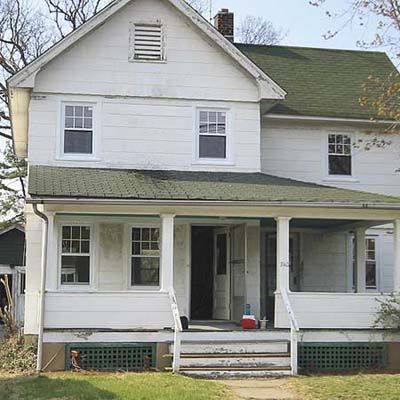
This 1920s farmhouse had dingy asbestos shingles, which detracted from the property’s charming character and posed a health risk.
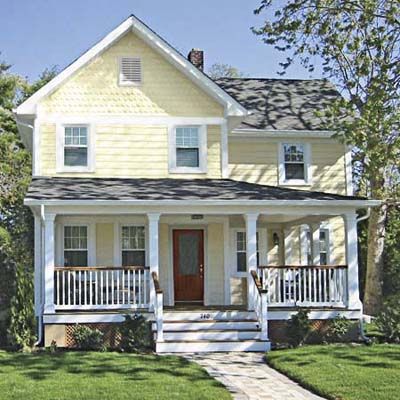
A field of spotless siding helps a home’s architectural details stand out. The owner chose new yellow vinyl clapboards that more closely matched the look of the original siding, offered easy maintenance, and set the stage for a friendlier entryway.
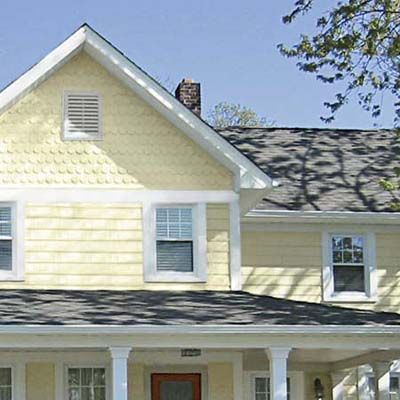
Matching fish-scale shingles go under the eaves of the peaked roof, adding some texture to visually break up the facade and replicate traditional architecture. The old and tattered green roof shingles were replaced with new gray asphalt ones that complemented the siding.
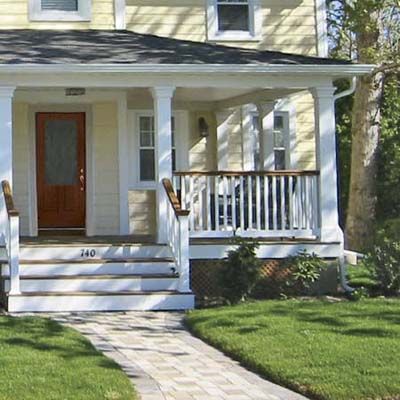
The homeowner also upgraded their porch, adding a white vinyl railing with rich-looking mahogany caps. The posts are wrapped in maintenance-free cellular PVC for durability, and the old builder-grade door was replaced with a charming windowed vinyl one. Foundation plants skirt the porch to make a link with the surrounding lawn, and attractive pavers replaced the old poured walkway.
Case Study 6: Adding a Handsome Roof
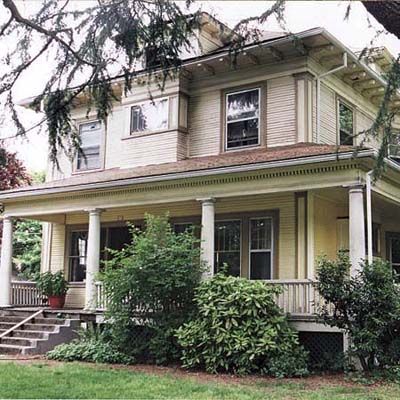
This early-1900s American Foursquare had a drab color palette and faded shingles. A roof can make or break the look of a facade, especially where a porch doubles its prominence.
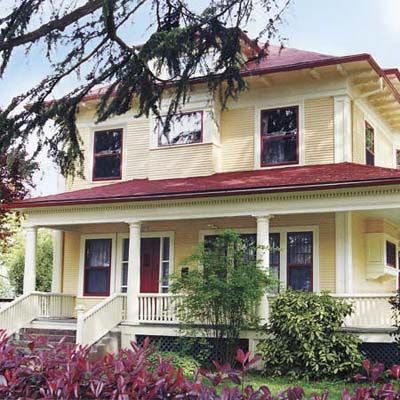
Now, the house has a vibrant new top and paint job. Wanting to go bold, the homeowners chose a rich red that draws the eye up, highlighting the rafter tails, dormers, and porch.
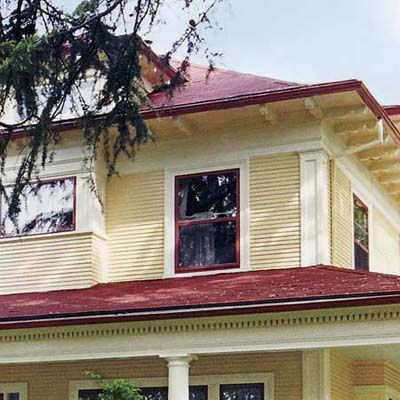
Four color families in nine different shades appear on the exterior, but the variations are subtle enough where the house doesn’t look like a circus tent. Golden yellow siding makes for a sunny backdrop, and red window sashes, muntins, and gutters tie into the roof. A dark blue-green lattice around the foundation fades into the landscaping.
